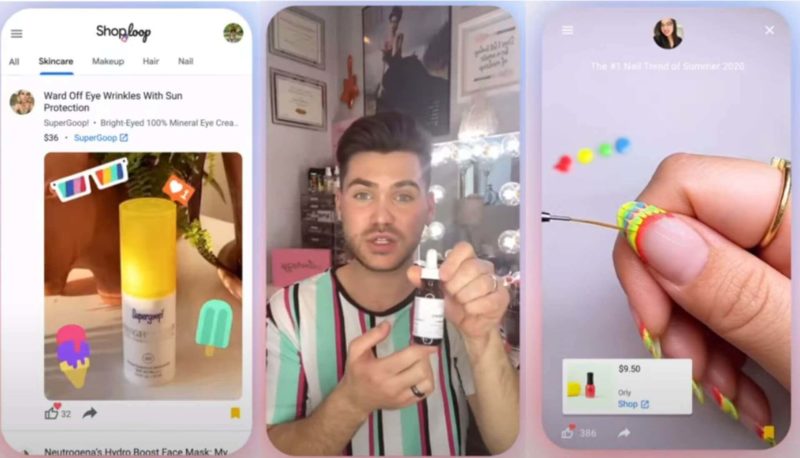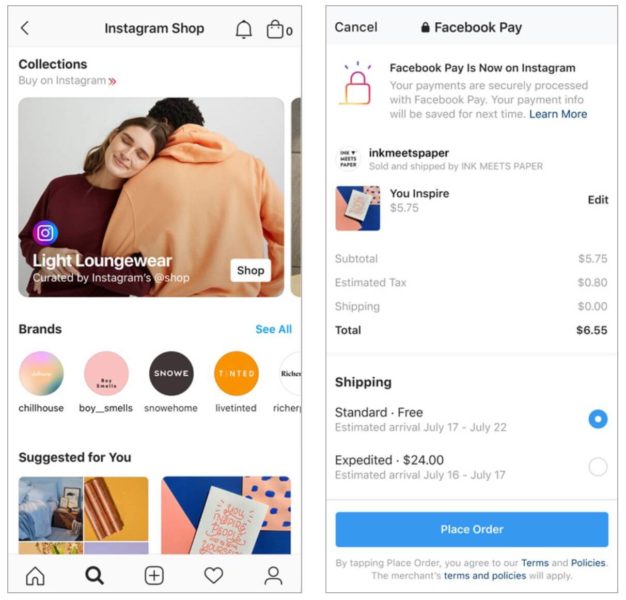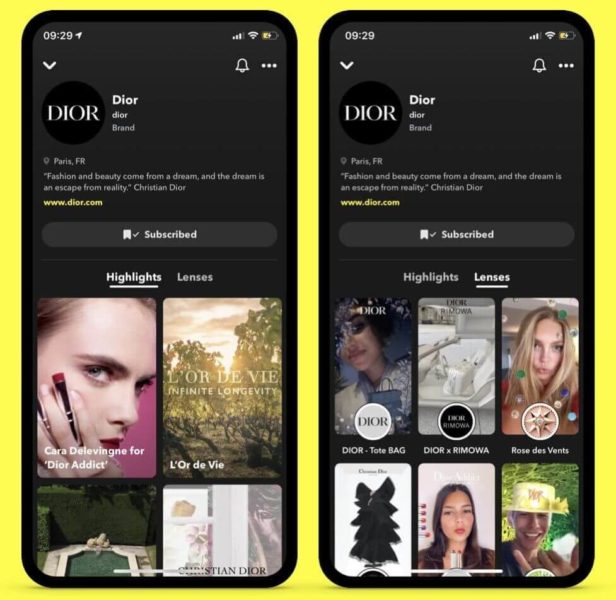Social Shorts: Google’s ShopLoop, Instagram Shop overhaul, Snapchat brand pages
ShopLoop: Google’s mobile commerce experiment Google’s experimental lab Area 120 is out with a new e-commerce experience for mobile web that incorporates social feed engagement and video product demos common on YouTube. Shoploop features a feed of short (90-seconds max) videos from creators using or talking about products. Every post links out to the relevant […]

ShopLoop: Google’s mobile commerce experiment
Google’s experimental lab Area 120 is out with a new e-commerce experience for mobile web that incorporates social feed engagement and video product demos common on YouTube. Shoploop features a feed of short (90-seconds max) videos from creators using or talking about products. Every post links out to the relevant product page on a retail site. Users can like, save and share posts and follow creators. The current product categories are makeup, skincare, hair and nail.

Why we care. Social commerce is gaining traction, led by Facebook’s Instagram shops, and Shoploop is Google’s effort to tap into it beyond YouTube. Who knows where this experiment will go, but it’s clearly aimed at the TikTok-loving, Instagram-shopping crowd. The mobile web approach is interesting, but without an app, discovery and repeat engagement could be a challenge. But it’s certainly more engaging than Amazon’s failed social commerce experiment Spark.
Instagram Shop makeover rolling out in the U.S. — with Facebook Pay
Facebook announced last week that the redesign of Instagram Shop is starting to roll out in the U.S. and that Facebook Pay will also be available in the coming weeks.
First teased in May, the updated Instagram Shop landing page includes personalized recommendations based on the brands users follow and the collections the Instagram @shop team creates.

Facebook Pay enables in-app payment across Facebook’s properties, including Instagram checkout. It also offers purchase protection, in this case on “eligible products” bought via Instagram checkout.
Why we care. Both of these initiatives are key pieces of Facebook’s e-commerce strategy to make its properties — and Instagram, in particular — commerce destinations with shoppable media and digital payment solutions. If you want a shot at getting on the Shop page, consistently tag products in your posts and create collections in your own Instagram shop.
Brands get a home base on Snapchat
Snapchat Brand Profiles. Following on last year’s launch of Public Profiles for creators and shows, Snapchat debuted Brand Profiles yesterday. In closed beta, Brand Profiles give brands a window front that showcases what they’re doing on the app, including AR Lenses, Stores, Highlights and Story posts.

Tools are available for team collaboration and content management. Analytics show audience demographics and interests of people who view brand Stories. Early participants include Ben & Jerry’s, Candy Crush, Dior, Gucci, Headspace, Jordan Brand, Kylie Cosmetics, L’Oreal Paris, Louis Vuitton, Prada, Ralph Lauren, Target, Tim Hortons, Too Faced, Universal Pictures, and VSCO.
Why we care. Brand pages will give brands better visibility on the app and should help increase engagement among Snapchat’s Gen Z and Millennial users. Snapchat says it will open Brand Profiles to more businesses later this year. We’re building toward a future where the Snapchat community can engage with businesses of all sizes across the variety of products on our service.
Pinterest brand safety questions
Pinterest’s systems don’t always filter harmful content and that its recommendation engine often surfaced that content, an investigation by OneZero found.
“Some problematic content is organically served to Pinterest users through recommendations based on their browsing behavior. But much of this content can be located through searches conducted while logged out of the platform, and on search engines like Google,” reported OneZero.
Why we care. Pinterest has taken many steps to demote, hide and flag misinformation and harmful content over the years, and while it has largely avoided the brand safety criticisms of Facebook, Twitter, and YouTube, the report shows that the site is not immune to questionable, offensive and abusive content that brands don’t want to associate with.
Would you pay for Twitter?
TikTok’s self-serve ad program (and trouble)
TikTok has rolled out its self-serve ad platform TikTok for Business Ads Manager globally along with a Back-to-Business ad credit program of $100 million for small businesses.
TikTok for Business Ads Manager features creative tools, budget flexibility and business accounts that have more tools.
The news for TikTok isn’t all good as it faces increasing scrutiny due to its ownership by the Chinese tech company ByteDance. On Friday, Amazon told employees to delete the TikTok app from phones on which they also access Amazon email, citing security concerns. The U.S. State Department has said it’s considering blocking it, and India has banned it along with other Chinese apps.
Why we care. TikTok was the most downloaded app last quarter, according to AppAnnie, and is just beginning to scale its advertising business. Government and private company actions could jeopardize its growth and monetization efforts.
Contributing authors are invited to create content for Search Engine Land and are chosen for their expertise and contribution to the search community. Our contributors work under the oversight of the editorial staff and contributions are checked for quality and relevance to our readers. The opinions they express are their own.
Related stories